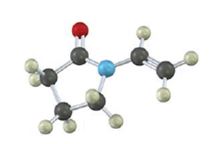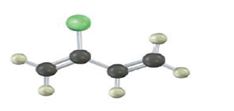
Concept explainers
a)

Interpretation:
Draw the structures of the
Concept introduction:
The term “polymer” is derived from the two words poly+mer. Where poly means ‘many’ and mer means ‘unit’, when combined known as polymer. The
The reaction mechanism may be classified into two categories:
Chain growth polymerization:
Chain growth polymers are produced by chain growth polymerization or addition polymerization. In this process an initiator is added to the reaction mixture. This initiator gets added to the carbon-carbon double bond and yields a reactive monomer (intermediate). This reactive intermediate reacts with the monomer and this process keeps on repeating to give rise to final polymeric product.
Step growth polymerization:
Step growth polymers are produced by step growth polymerization or condensation polymerization. In this process, each bond is formed in a step wise manner. In this the product of each is again a bi-
b)

Interpretation:
Draw the structures of the polymers formed by the given monomer units.
Concept introduction:
The term “polymer” is derived from the two words poly+mer. Where poly means ‘many’ and mer means ‘unit’, when combined known as polymer. The polymerization is the process of reacting monomer molecules together in a chemical reaction to give rise to a polymer. If the reacting units are same then this type of polymer is known as homopolymer and if the reaction takes place between different molecules then it is called copolymer.
The reaction mechanism may be classified into two categories:
Chain growth polymerization:
Chain growth polymers are produced by chain growth polymerization or addition polymerization. In this process an initiator is added to the reaction mixture. This initiator gets added to the carbon-carbon double bond and yields a reactive monomer (intermediate). This reactive intermediate reacts with the monomer and this process keeps on repeating to give rise to final polymeric product.
Step growth polymerization:
Step growth polymers are produced by step growth polymerization or condensation polymerization. In this process, each bond is formed in a step wise manner. In this the product of each is again a bi-functional group and the condensation goes on.
Want to see the full answer?
Check out a sample textbook solution
Chapter 31 Solutions
OWLv2 with Student Solutions Manual eBook, 4 terms (24 months) Printed Access Card for McMurry's Organic Chemistry, 9th
- So, the first image is what I'm trying to understand regarding my approach. The second image illustrates my teacher's method, and the third image includes my notes on the concepts behind these types of problems.arrow_forwardHAND DRAWarrow_forwardDraw a mental model for calcium chloride mixed with sodium phosphatearrow_forward
- here is my question (problem number 20) please explain to me thanks!arrow_forwardThe bromination of anisole is an extremely fast reaction. Complete the resonance structures of the intermediate arenium cation for the reaction (Part 1), and then answer the question that follows (Part 2).arrow_forwardDrawing of 3-fluro-2methylphenolarrow_forward
- Which compound(s) will be fully deprotonated (>99%) by reaction with one molar equivalent of sodium hydroxide? I, II, III I, || I, III I only II, III SH | H3C-C=C-H || III NH2arrow_forwardWill NBS (and heat or light) work for this reaction, or do we have to use Br2?arrow_forwardHAND DRAWarrow_forward
 Chemistry & Chemical ReactivityChemistryISBN:9781133949640Author:John C. Kotz, Paul M. Treichel, John Townsend, David TreichelPublisher:Cengage Learning
Chemistry & Chemical ReactivityChemistryISBN:9781133949640Author:John C. Kotz, Paul M. Treichel, John Townsend, David TreichelPublisher:Cengage Learning Chemistry: Principles and ReactionsChemistryISBN:9781305079373Author:William L. Masterton, Cecile N. HurleyPublisher:Cengage Learning
Chemistry: Principles and ReactionsChemistryISBN:9781305079373Author:William L. Masterton, Cecile N. HurleyPublisher:Cengage Learning Introductory Chemistry: An Active Learning Approa...ChemistryISBN:9781305079250Author:Mark S. Cracolice, Ed PetersPublisher:Cengage Learning
Introductory Chemistry: An Active Learning Approa...ChemistryISBN:9781305079250Author:Mark S. Cracolice, Ed PetersPublisher:Cengage Learning ChemistryChemistryISBN:9781305957404Author:Steven S. Zumdahl, Susan A. Zumdahl, Donald J. DeCostePublisher:Cengage Learning
ChemistryChemistryISBN:9781305957404Author:Steven S. Zumdahl, Susan A. Zumdahl, Donald J. DeCostePublisher:Cengage Learning Chemistry: An Atoms First ApproachChemistryISBN:9781305079243Author:Steven S. Zumdahl, Susan A. ZumdahlPublisher:Cengage Learning
Chemistry: An Atoms First ApproachChemistryISBN:9781305079243Author:Steven S. Zumdahl, Susan A. ZumdahlPublisher:Cengage Learning





